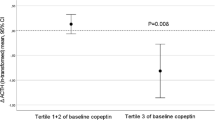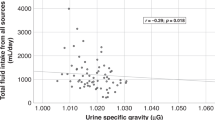Abstract
Background/Objective
Evidence from non-human species indicate that hydration and arginine vasopressin (AVP) influence fuel selection, energy expenditure (EE), and food intake, but these relationships are unclear in humans. We sought to assess whether hydration biomarkers [24-h urine volume (UVol) and urine urea nitrogen concentration (UUN)] and copeptin (a surrogate for AVP) are associated with 24-h EE, respiratory quotient (RQ), and daily energy intake (DEI).
Subjects/Methods
In a secondary analysis of collected data, we selected healthy adults (Group 1, n = 177) who had 24-h whole-room indirect calorimetry measurements in energy balance with 24-h urine collection and fasting copeptin measurements (n = 117), followed by 3 days ad libitum food intake. A separate group (Group 2, n = 284) with hydration markers and calorimetry measurements was also studied. The main outcome measures were 24-h RQ, 24-h EE, DEI, substrate oxidation.
Results
In Group 1, lower 24-h UVol and higher 24-h UUN, indicating lower hydration, were correlated with lower 24-h RQ (r = 0.35, p < 0.0001, and r = −0.29, p = 0.0001, respectively; results similar in Group 2) and predicted subsequent reduced DEI (r = 0.20, p = 0.01, and r = −0.27, p = 0.0003, respectively), adjusted for confounders. Copeptin was independently associated with 24-h lipid oxidation (r = −0.23, p = 0.01). In Group 2, lower hydration was associated with reduced 24-h EE (24-h UVol: r = 0.29, p < 0.0001; 24-h UUN: r = −0.25, p < 0.0001).
Conclusions
Hydration biomarkers were associated with metabolic differences characterized by altered food intake, fuel selection, and possibly EE. Independently, copeptin was associated with higher lipid oxidation.
This is a preview of subscription content, access via your institution
Access options
Subscribe to this journal
Receive 12 print issues and online access
$259.00 per year
only $21.58 per issue
Buy this article
- Purchase on Springer Link
- Instant access to full article PDF
Prices may be subject to local taxes which are calculated during checkout




Similar content being viewed by others
References
Mavani GP, DeVita MV, Michelis MF. A review of the nonpressor and nonantidiuretic actions of the hormone vasopressin. Front Med. 2015;2:19.
Enhorning S, Melander O. The Vasopressin System in the risk of diabetes and cardiorenal disease, and hydration as a potential lifestyle intervention. Ann Nutr Metab. 2018;72(Suppl 2):21–7.
Zurlo F, Lillioja S, Esposito-Del Puente A, Nyomba B, Raz I, Saad M, et al. Low ratio of fat to carbohydrate oxidation as predictor of weight gain: study of 24-h RQ. Am J Physiol-Endocrinol Metab. 1990;259:E650–7.
Piaggi P, Thearle MS, Krakoff J, Votruba SB. Higher daily energy expenditure and respiratory quotient, rather than fat-free mass, independently determine greater ad libitum overeating. J Clin Endocrinol Metab. 2015;100:3011–20.
Piaggi P, Thearle MS, Bogardus C, Krakoff J. Lower energy expenditure predicts long-term increases in weight and fat mass. J Clin Endocrinol Metab. 2013;98:E703–7.
Pannacciulli N, Salbe AD, Ortega E, Venti CA, Bogardus C, Krakoff J. The 24-h carbohydrate oxidation rate in a human respiratory chamber predicts ad libitum food intake. Am J Clin Nutr. 2007;86:625–32.
Ravussin E, Lillioja S, Knowler WC, Christin L, Freymond D, Abbott WG, et al. Reduced rate of energy expenditure as a risk factor for body-weight gain. New Engl J Med. 1988;318:467–72.
Stookey JJ. Negative, null and beneficial effects of drinking water on energy intake, energy expenditure, fat oxidation and weight change in randomized trials: a qualitative review. Nutrients. 2016;8:E19.
Hohenegger M, Laminger U, Om P, Sadjak A, Gutmann K, Vermes M. Metabolic effects of water deprivation. J Clin Chem Clin Biochem. 1986;24:277–82.
Kitada K, Daub S, Zhang Y, Klein JD, Nakano D, Pedchenko T, et al. High salt intake reprioritizes osmolyte and energy metabolism for body fluid conservation. J Clin Invest. 2017;127:1944–59.
Kocelak P, Zak-Golab A, Rzemieniuk A, Smetek J, Sordyl R, Tyrka A, et al. The influence of oral water load on energy expenditure and sympatho-vagal balance in obese and normal weight women. Arch Med Sci. 2012;8:1003–8.
Dubnov-Raz G, Constantini NW, Yariv H, Nice S, Shapira N. Influence of water drinking on resting energy expenditure in overweight children. Int J Obes. 2011;35:1295–300.
Boschmann M, Steiniger J, Franke G, Birkenfeld AL, Luft FC, Jordan J. Water drinking induces thermogenesis through osmosensitive mechanisms. J Clin Endocrinol Metab. 2007;92:3334–7.
Boschmann M, Steiniger J, Hille U, Tank J, Adams F, Sharma AM, et al. Water-induced thermogenesis. J Clin Endocrinol Metab. 2003;88:6015–9.
Sharief NN, Macdonald I. Differences in dietary-induced thermogenesis with various carbohydrates in normal and overweight men. Am J Clin Nutr. 1982;35:267–72.
Watts AG, Sanchez-Watts G, Kelly AB. Distinct patterns of neuropeptide gene expression in the lateral hypothalamic area and arcuate nucleus are associated with dehydration-induced anorexia. J Neurosci. 1999;19:6111–21.
Watts AG, Boyle CN. The functional architecture of dehydration-anorexia. Physiol Behav. 2010;100:472–7.
Bolles RC. The interaction of hunger and thirst in the rat. J Comp Physiol Psychol. 1961;54:580–4.
Finger FW, Reid LS. The effect of water deprivation and subsequent satiation upon general activity in the rat. J Comp Physiol Psychol. 1952;45:368–72.
Engell D. Interdependency of food and water intake in humans. Appetite. 1988;10:133–41.
Phillips PA, Rolls BJ, Ledingham JG, Morton JJ. Body fluid changes, thirst and drinking in man during free access to water. Physiol Behav. 1984;33:357–63.
de Castro JM. A microregulatory analysis of spontaneous fluid intake by humans: evidence that the amount of liquid ingested and its timing is mainly governed by feeding. Physiol Behav. 1988;43:705–14.
Yoshimura M, Nishimura K, Nishimura H, Sonoda S, Ueno H, Motojima Y, et al. Activation of endogenous arginine vasopressin neurons inhibit food intake: by using a novel transgenic rat line with DREADDs system. Sci Rep. 2017;7:15728.
Meyer AH, Langhans W, Scharrer E. Vasopressin reduces food intake in goats. Q. J Exp Physiol. 1989;74:465–73.
Koshimizu TA, Nakamura K, Egashira N, Hiroyama M, Nonoguchi H, Tanoue A. Vasopressin V1a and V1b receptors: from molecules to physiological systems. Physiol Rev. 2012;92:1813–64.
Morgenthaler NG, Struck J, Alonso C, Bergmann A. Assay for the measurement of copeptin, a stable peptide derived from the precursor of vasopressin. Clin Chem. 2006;52:112–9.
Enhorning S, Bankir L, Bouby N, Struck J, Hedblad B, Persson M, et al. Copeptin, a marker of vasopressin, in abdominal obesity, diabetes and microalbuminuria: the prospective Malmo Diet and Cancer Study cardiovascular cohort. Int J Obes. 2013;37:598–603.
Perrier E, Vergne S, Klein A, Poupin M, Rondeau P, Le Bellego L, et al. Hydration biomarkers in free-living adults with different levels of habitual fluid consumption. Br J Nutr. 2013;109:1678–87.
Perrier E, Rondeau P, Poupin M, Le Bellego L, Armstrong LE, Lang F, et al. Relation between urinary hydration biomarkers and total fluid intake in healthy adults. Eur J Clin Nutr. 2013;67:939–43.
Armstrong LE, Johnson EC, Munoz CX, Swokla B, Le Bellego L, Jimenez L, et al. Hydration biomarkers and dietary fluid consumption of women. J Acad Nutr Diet. 2012;112:1056–61.
Venti CA, Votruba SB, Franks PW, Krakoff J, Salbe AD. Reproducibility of ad libitum energy intake with the use of a computerized vending machine system. Am J Clin Nutr. 2010;91:343–8.
Weise CM, Hohenadel MG, Krakoff J, Votruba SB. Body composition and energy expenditure predict ad-libitum food and macronutrient intake in humans. Int J Obes. 2014;38:243–51.
Lillioja S, Mott DM, Spraul M, Ferraro R, Foley JE, Ravussin E, et al. Insulin resistance and insulin secretory dysfunction as precursors of non-insulin-dependent diabetes mellitus. Prospective studies of Pima Indians. N Engl J Med. 1993;329:1988–92.
Ferraro R, Boyce VL, Swinburn B, De Gregorio M, Ravussin E. Energy cost of physical activity on a metabolic ward in relationship to obesity. Am J Clin Nutr. 1991;53:1368–71.
Genuth S, Alberti K, Bennett P, Buse J, DeFronzo R, Kahn R, et al. Follow-up report on the diagnosis of diabetes mellitus. Diabetes care. 2003;26:3160–8.
Votruba SB, Kirchner H, Tschop M, Salbe AD, Krakoff J. Morning ghrelin concentrations are not affected by short-term overfeeding and do not predict ad libitum food intake in humans. Am J Clin Nutr. 2009;89:801–6.
Ravussin E, Lillioja S, Anderson TE, Christin L, Bogardus C. Determinants of 24-hour energy expenditure in man. Methods and results using a respiratory chamber. J Clin Investig. 1986;78:1568.
Tataranni PA, Ravussin E. Use of dual-energy X-ray absorptiometry in obese individuals. Am J Clin Nutr. 1995;62:730–4.
Chang DC, Piaggi P, Krakoff J. A novel approach to predict 24-hour energy expenditure based on hematologic volumes: development and validation of models comparable to Mifflin-St Jeor and body composition models. J Acad Nutr Diet. 2017;117:1177–87.
Abbott WG, Howard BV, Christin L, Freymond D, Lillioja S, Boyce VL, et al. Short-term energy balance: relationship with protein, carbohydrate, and fat balances. Am J Physiol. 1988;255(3 Pt 1):E332–7.
Jequier E, Acheson K, Schutz Y. Assessment of energy expenditure and fuel utilization in man. Annu Rev Nutr. 1987;7:187–208.
Storey KB, Storey JM. Aestivation: signaling and hypometabolism. J Exp Biol. 2012;215(Pt 9):1425–33.
Ramnanan CJ, McMullen DC, Groom AG, Storey KB. The regulation of AMPK signaling in a natural state of profound metabolic rate depression. Mol Cell Biochem. 2010;335:91–105.
Rofe AM, Williamson DH. Mechanism for the ‘anti-lipolytic’ action of vasopressin in the starved rat. Biochem J. 1983;212:899–902.
Beglinger S, Drewe J, Christ-Crain M. The Circadian rhythm of copeptin, the C-terminal portion of arginine vasopressin. J Biomark. 2017;2017:4737082.
Meijer E, Bakker SJ, van der Jagt EJ, Navis G, de Jong PE, Struck J, et al. Copeptin, a surrogate marker of vasopressin, is associated with disease severity in autosomal dominant polycystic kidney disease. Clin J Am Soc Nephrol. 2011;6:361–8.
Meijer E, Bakker SJ, Halbesma N, de Jong PE, Struck J, Gansevoort RT. Copeptin, a surrogate marker of vasopressin, is associated with microalbuminuria in a large population cohort. Kidney Int. 2010;77:29–36.
Enhorning S, Tasevska I, Roussel R, Bouby N, Persson M, Burri P. et al. Effects of hydration on plasma copeptin, glycemia and gluco-regulatory hormones: a water intervention in human. Eur J Nutr. 2017;58:315–24.
Acknowledgements
We thank the nursing, clinical, and dietary staffs and laboratory technicians of the clinical research center for their valuable assistance and care of the volunteers.
Funding
This research was supported by the Intramural Research Program of the National Institutes of Health, National Institute of Diabetes and Digestive and Kidney Diseases.
Author information
Authors and Affiliations
Contributions
DCC, AB, PP, SBV, and JK designed the study. DCC, PP, and JK designed the statistical analysis plan and analyzed the data. DCC wrote the manuscript and AB, PP, SBV, and JK edited the manuscript. DCC is the guarantor of the work and, as such, had full access to all the study data and takes responsibility for the integrity of the data and the accuracy of the data analysis.
Corresponding author
Ethics declarations
Conflict of interest
The authors declare that they have no conflict of interest.
Additional information
Publisher’s note: Springer Nature remains neutral with regard to jurisdictional claims in published maps and institutional affiliations.
Supplementary information
Rights and permissions
About this article
Cite this article
Chang, D.C., Basolo, A., Piaggi, P. et al. Hydration biomarkers and copeptin: relationship with ad libitum energy intake, energy expenditure, and metabolic fuel selection. Eur J Clin Nutr 74, 158–166 (2020). https://doi.org/10.1038/s41430-019-0445-6
Received:
Revised:
Accepted:
Published:
Issue Date:
DOI: https://doi.org/10.1038/s41430-019-0445-6
This article is cited by
-
Investigation of seasonality of human spontaneous physical activity and energy expenditure in respiratory chamber in Phoenix, Arizona
European Journal of Clinical Nutrition (2024)



